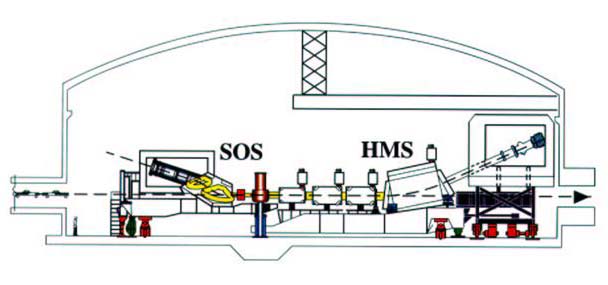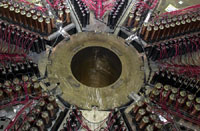Status and Goals
Status and Goal as described in the JLab Institutional Plan 02-06 (published in Sept. 2001)

Hall C's initial complement of equipment (shown in the figure), includes two general-purpose magnetic spectrometers. The High Momentum Spectrometer (HMS) has a large solid angle, a moderate resolution (10-3), and a maximum momentum of 7 GeV/c. The Short Orbit Spectrometer (SOS) has a large momentum acceptance and a very short (7.4 meter) optical path to facilitate the detection of particles having short lifetimes, such as s and Ks. All equipment is operating at design specifications. Since the start of the physics program in November 1997 through February 2001, a total of twelve experiments have been completed in Hall C covering a broad spectrum of topics in nuclear physics, and about half the desired data has (intentionally) been obtained on two additional experiments. Experiments using the standard equipment in the Hall have investigated a broad variety of phenomena ranging from the pion form factor, deuteron photo disintegration at high energies, color transparency, kaon production, excitation of the delta resonance in the proton, duality, and deep inelastic scattering in nuclei for x > 1. Hall C was planned to support the installation of additional specialized detectors designed to investigate specific problems. Examples to date include: the t20 experiment (E94-018), which separated the elastic form factors of the deuteron to high momentum transfer ; the HNSS experiment (E89-009), which demonstrated the feasibility of performing hypernuclear physics experiments at JLab; and, most recently (4/01) E93-038, a measurement of , the electric form factor of the neutron, to high Q2 using a high current polarized electron beam and a neutron polarimeter.
A hypernucleus is a nucleus in which one of the nucleons has been replaced
by its strange counterpart, the L hyperon. Experiments in which hypernuclei
are formed using electroproduction are complementary to those involving
the more traditional pion-production approach, as they emphasize unnatural
parity and high-L states, where pion production emphasizes natural parity
and low-L states. With the HNSS experiment successfully completed, the
collaboration has begun the next phase of the program, which will include
the construction of a major new spectrometer facility
for hypernuclei studies (funded primarily
by our Japanese collaborators). The Program Advisory Committee (PAC) has
approved the facility and its first experiment.
Additional major installation experiments planned in Hall C include:
- a second, complementary measurement of the neutron electric form factor using a polarized target and low-current polarized beam (E93-026), and
- precision measurements of parity violation in the scattering of polarized electrons from protons to investigate their weak neutral current structure and possible contributions from strange quarks to the proton electro-magnetic structure (E91-017), to be carried out using a major new specialized apparatus now nearing completion the G0 spectrometer. The G0 experiment will measure the contribution of the and quarks to the magnetization and charge distributions of the proton and neutron down to a few percent of their natural values of unity.


